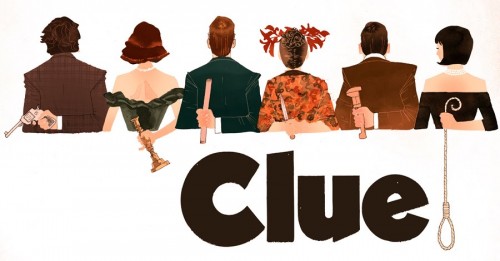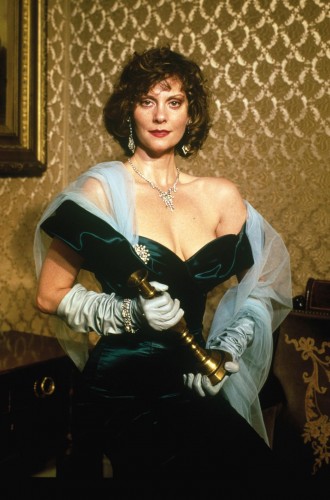
This guest post by Erin K. O’Neill appears as part of our theme week on Cult Films and B Movies.
Six strangers gather in a New England mansion for a mysterious dinner party. It is revealed that their host is blackmailing them all, but then the tale darkens. First the host is murdered, and then the cook and the maid – and to make a long story short…
Too late!
On any dark and stormy night in the fall, it is a wonderful thing to curl up with a mug of mulled cider and watch Clue. The murder mystery based on the eponymous board game may have been a huge flop when it was released in 1985, but it has gained a passionate cult following in the last 28 years, probably due to its infinitely quotable dialogue and gleeful disregard for the pile of bodies amassed as the movie progresses – as well as being shown on cable about once every two hours.

I seriously love Clue. It’s my favorite board game and one of my favorite movies, and has been since one of my friends sat me down and made me watch it one Halloween a long time ago. It’s bawdy and brash and downright hilarious, especially if you have a taste for farcical whodunits.
But: Does it pass the Bechdel Test?
- It has to have at least two named women in it,
- who talk to each other,
- about something besides a man.
In order to help you understand whether or not Clue passes the Bechdel Test, I shall need to take you through the criteria of the test, step by step.
1. Does the movie have two named women in it?
There are five women characters who have names in Clue.
- Mrs. Peacock, the hysterical senator’s wife.
- Mrs. White, the widow of a nuclear physicist.
- Miss Scarlett, Madam of a Washington D.C. brothel.
- Yvette, the maid and Miss Scarlett’s former employee.
- Mrs. Ho, the cook. While being listed in the credits as “The Cook,” in one of the first scenes in the movie Wadsworth calls her by her name.
In fact, in the entire movie only one female character doesn’t have a name, and that’s the Singing Telegram Girl.
And so, Clue passes the first step in the Bechdel Test.
2. Do these women talk to each other?
Absolutely. Clue is an ensemble movie with a mile-a-minute dialogue – and more one-liners than I care to count. So, here are a few of my favorite exchanges:
Miss Scarlet: Maybe there is life after death.
Mrs. White: Life after death is as improbable as sex after marriage!
Mrs. White: Maybe he wasn’t dead.
Professor Plum: He was!
Mrs. White: We should’ve made sure.
Mrs. Peacock: How? By cutting his head off, I suppose.
Mrs. White: That was uncalled for!
Miss Scarlet: What was he like?
Mrs. White: He was always a rather stupidly optimistic man. I mean, I’m afraid it came as a great shock to him when he died, but, he was found dead at home. His head had been cut off, and so had his, uh… you *know.*
[Colonel Mustard, Professor Plum, and Mr. Green cross legs]
Mrs. White: I had been out all evening at the movies.
Miss Scarlet: Do you miss him?
Mrs. White: Well, it’s a matter of life after death. Now that he’s dead, I have a life.
And so, Clue passes the second step in the Bechdel Test.

3. Do the women talk to each other about something besides a man?
The third leg of the Bechdel Test is often the one movies fail – while there are often women characters, how often do they not speak of men? And Clue has some integral issues with the plot and structure that would make it difficult to pass this leg of the test.
For one, the movie is an ensemble with a male butler at the center. Wadsworth, throughout the film, controls the action and guides the other players through the plot – he holds all the cards and asks all the questions. Furthermore, it’s a murder mystery where the first and most crucial victim, Mr. Boddy, is a man. Much of the dialogue, even if it’s about murder, is about a man.
And finally, Mrs. Peacock, Mrs. White and Miss Scarlett are all being blackmailed for actions that entirely have to do with men: Mrs. Peacock for accepting bribes for her husband’s senate vote; Mrs. White for allegedly killing her husband (and possibly at least one of her previous husbands too); and Miss Scarlett for running a house of ill repute that caters to men. This means that even when the women are discussing their histories and their motivations, the topic of conversation is men.
In the dinner scene, Mrs. Peacock tries to start conversation by asking the other women about their husbands and asking the men about their careers. It’s a telling moment, which could perhaps be forgiven by the film’s setting in 1954, which reveals how narrow topics of conversation for women can be. Even in 1954, they could have discussed Abstract Expressionism, or thematically, the McCarthy hearings on the House Committee of Un-American Activities. After all, communism is just a red herring.
I’ve seen Clue, well, let’s just say a lot. And, I had to rewatch the film three times but also scour a copy of the shooting script to find any dialogue where two women talk about something besides a man. As far as I can tell, it happened twice:
Miss Scarlett: Would you like to see these Yvette? They might shock you.
Yvette: No, thank you. I am a lady.
Miss Scarlett: And how do you know what sort of pictures they are if you’re such a lady?
Mrs. Peacock: Uh, is there a little girl’s room in the hall?
Yvette: Oui oui, Madame.
[points]
Mrs. Peacock: No, I just want to powder my nose.
Yep. The second instance is a pun on peeing.

Are these two, three-line exchanges enough to pass the Bechdel Test? There appears to be much debate about this leg of the test. Some critics claim that in order to pass, the women must speak to each other for more than 60 seconds, or that there must be some depth to the conversations. Since the original comic makes no such distinction and states that the two women must simply talk to each other about non-men related topics, I would argue that their two bits of dialogue meet the criteria.
And so, Clue passes the third step in the Bechdel Test, by the skin of its teeth.
Erin K. O’Neill is an award-winning writer, photographer, and visual editor currently located in her hometown of Ann Arbor, Michigan. A devotee of literature, photography, existentialism, and all things Australian, Erin also watches too much television on DVD and Netflix. Follow her on Twitter, @ekoneill.
